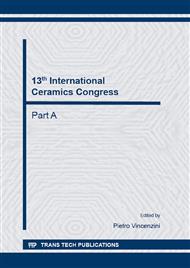p.113
p.118
p.126
p.132
p.139
p.145
p.151
p.157
p.162
Effect of Different Sintering Processes on Microstructure of Alumina Ceramics
Abstract:
Structural ceramics, such as alumina, are widely used in industrial applications due to their properties such as hardness, chemical resistance and thermal stability in high temperatures. However, low fracture toughness has limited applications of these materials. One way to overcome the low fracture toughness is to control the microstructure, seeking a refined and homogeneous microstructure. In this way, the aim of this study was to investigate the effect of unconventional methods sintering based on two steps and microwaves sintering methods on the microstructure of a commercial alumina ceramic. From two-steps sintering method, the samples are first heated to a high temperature and then cooled down to a lower than one temperature to suppress grain-boundary migration. Ceramics obtained by microwave sintering method were produced after 1100, 1300 and 1350°C for 1 hour. The microwave heating method reduces the time and temperature processing, which results in energy saving. The sintered samples were characterized by apparent density, scanning electron microscopy and measurements of grain size. The results showed that two-steps sintering and microwave were effective to control the microstructure of alumina and that in two steps sintering it is essential to control the sintering steps to inhibit grain growth.
Info:
Periodical:
Pages:
145-150
Citation:
Online since:
October 2014
Keywords:
Price:
Сopyright:
© 2014 Trans Tech Publications Ltd. All Rights Reserved
Share:
Citation:


